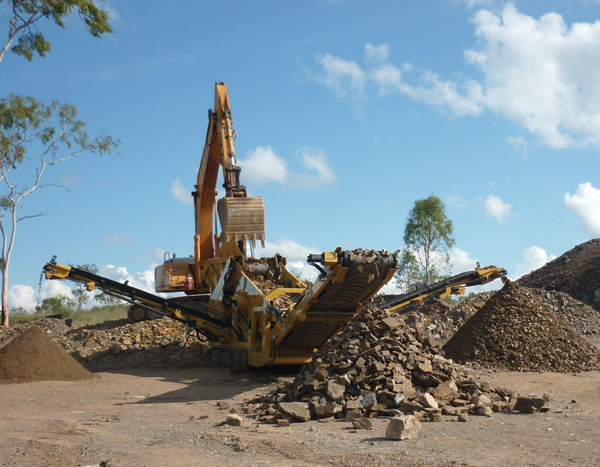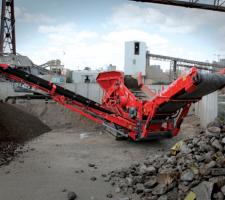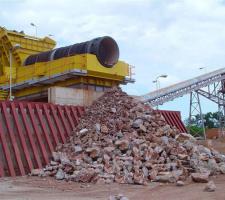
Mobile screen technology is helping to cut costs on site but there is still a market for stationary solutions. Claire Symes reports
While aggregate demand from large population centres still calls for a static screens' capacity, on site screening using mobile equipment is helping to reduce costs on some construction projects.
Last year ABE reported on the use of mobile equipment by Eren Insaat in Eastern Turkey to turn blasted material into aggregates as construction on the canal project progressed. This is one of a growing number of projects using mobile screens to create a moving quarry -
Main contractor Baltt Empreiteira Transportes e Terraplenagem is moving the Sandvik QA450 triple deck screener, QH330 cone crusher and QJ340 jaw crusher as work on the scheme progresses. The QA450 is being used to screen up to 160tonnes per hour of granite into 0-6mm, 6-12mm, 12-19mm and over 19mm products.
"We are seeing more contractors carrying out processing on the construction site," said
"This approach shows a change in mindset and contractors seeing a new way of doing things now that mobile units have the capacity to match static plants." Sandvik feeder and screens global product line manager Petri Mehto said, "There is a real trend towards mobile screens. The trend has been increased by the economic crisis because it is easier to finance a mobile unit as the banks can see this is a saleable asset should the worst happen.
"Lead times are also driving the move to mobile. It can take many months to specify and install a static screen but mobile units are available almost immediately."
Compact demand
Mobility between sites and fast set-up times are two of the factors that are driving the demand in the mobile screen sector, according to Northern Ireland-based manufacturer
"Our ability to ship all screens in 40' containers without any breakdown is a huge selling point as it reduces the shipping cost dramatically," explained Anaconda managing director Alistair Forsyth.
"This cost saving is passed onto the end user making the product price very attractive when compared to other imported screens." Nonetheless, Forsyth added that customers still want these compact solutions to deliver high capacities.
Demand for capacity is also driving another trend that Mehto has noticed in the last year or so. "There is growing demand for what I call 'quick and dirty' screens," he said. "These are being used at the face as pre-screeners to help improve productivity in other parts of the crushing and screening chain. I think these will become increasingly popular."
Polarised demands
While other construction equipment is becoming more hi-tech, quarry operators are split on what they want in terms of technology on new screens. "Larger operators want complete plant control using PLC systems," said Lilley, "while smaller operators and contractors prefer simple hydraulics." Mehto added, " The difference is really polarising the sector - some customers are very focused on the initial costs, whereas operators of larger screens are focused on lifespan and ease of maintenance.
Waste processing
Installation of a new Hercules trommel by Stelex at a quarry in Tanzania is helping the customer to deal with over 3million tonnes of limestone waste material and earn money from the waste.
Without the necessary equipment to process the mix of limestone and clay - which was often heavily waterlogged in the rainy season - the quarry was forced to stockpile the material since the site opened 30 years ago.
Now the HT182 heavy duty trommel, which is mounted on concrete walls with an underscreen feeder and stockpile conveyor, is processing up to 500tonnes per hour. The waste material is around 60% limestone with blocks of up to 1m3, which can be recovered for aggregate production, while the clay material is being used for re-profiling work elsewhere on site.
"You can see the difference in the types of screening media they choose. The ones focusing on lower outlays go for steel wire mesh, while the operational cost conscious operator goes for polyurethane or rubber screening media." Metso Minerals vice president of screening media Mats Dahlberg said that one of the biggest demands was for more uptime and looking at the screening media can help to deliver this along with capacity, accuracy and reliability.
"There are three traditional solutions for media - tension cloth with wire or polyurethane, panels or modular," he said. "The fastest growing trend is to use modular solutions on static or larger mobile screens. The main drivers are that it is easier to meet the requirements with a modular system by delivering a higher open area, which resists pegging and offers better accuracy.
"Panel solutions tend to have punched apertures, which are prone to pegging, plus wear on the tooling used to make the panel means that the panels may have variations. Modular solutions are moulded so are more uniform, plus they work better in inclined operations and reduce pegging." According to Dahlberg, it is easier to optimise screening using modular media as a mix of solutions can be used on different decks to give the best overall result. "A heavy duty system can be applied to the first deck to reduce wear caused by the impact of material landing on the screen," he said. "It is also easier to replace sections that wear more quickly. If you use a tension cloth then the whole thing has to be replaced even if only one part is worn.
Recycled options
Delivery of a new screen to UK-based Day Aggregates is helping the company to develop a new recycling process. The Terex Finlay 863 screen is being used at Murphy's Wharf in Charlton to process waste to create hydraulically bound mixtures (HBM).
Day is selling the HBM under the EcoFILL brand name and is being used by contractors as a back-filling material for operations in applications such as trenching.
The 863 has been built to a bespoke specification to meet Day's exact needs. Finlay Plant South East managing director.
Leon Sheehy said he worked closely with Day to specify the machine. "After an evaluation process we were able to recommend a bespoke specification that was tailored to their requirements," he said.
"This has a significant impact on improving health and safety during maintenance and reducing waste. These factors are starting to become buying criteria for some major quarry operators." On smaller screens - those generally used by contractors - there is a cost issue that prevents modular media being the ideal solution. "Because these machines are moved from site to site frequently, they don't want to optimise the screen for just one client but need to have flexibility, so they tend to use wire mesh media to give the biggest open area," explained Dahlberg.
"The issue with wire mesh is that it is weaved and the raised joints are prone to wear so we are developing a hybrid solution that is totally flat and uses polyurethane for bonding to give a longer service life with the maximum surface area. The system does away with the transverse wire so offers more vibration as the system is not as rigid." Canada-based media manufacturer Major Wire is also developing new products to meet market demand. The company's products have focused on producing 1x1 panels but the market also demands 1x2 and 1x4 panels so Major Wire has focused on developing the 1x2 version of its 1x1 product. The larger size has the benefit of having more open area.
"Quarry operators want more capacity and fewer panels to handle when it comes to maintenance," said Major Wire president and CEO Jean Leblond. "But in the current economic climate, they also want to be able to produce more material in fewer working hours in order to reduce costs." Leblond said that he still sees a recession in the aggregates market and this is driving demand for solutions that can increase productivity and reduce costs but customers are still investing in quality screening media to achieve this. He added that more operators are moving from rigid polyurethane and wire media to flexible systems to achieve this.
Military service
Mobile screening proved to be the ideal solution for the US-based South Dakota National Guard when it came to filling sand bags to reinforce levees on the Missouri River recently. A 271K screen owned by Harold Goeden of First Rate Excavate was used to process up to 250tonnes per hour of sand for the flood relief work. Filled bags were airlifted into position by a UH60 Blackhawk helicopter.

















